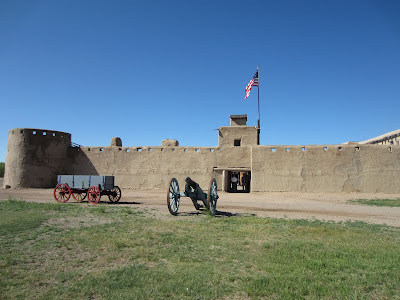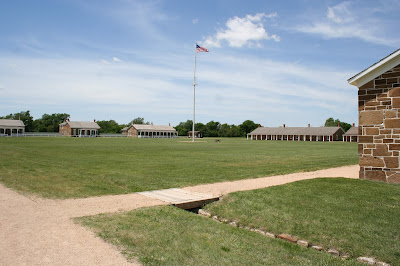Along the Santa Fe National Historic Trail
I became a historian because of the Santa Fe Trail. As a
teenager, I hiked fifty miles of the trail with my Boy Scout troop. In the
1980s, I drove art to Denver and got grabbed by the trail again. To kick off
this part of my Driven by History road trip, I will travel up the Santa Fe
Trail and stop at several key places along the way.
I started my trail journey at the southern end of Interstate 25,
near the border with Mexico. I traveled north along the historic El Camino Real
de Tierra Adentro (covered in the March 14th, 2016 blog). I drove north in the Beagle, through New Mexico and through my
past. I punched through Albuquerque, where I grew up, and past Santa Fe where I
became an adult. At Santa Fe, continuing on I-25, I left El Camino Real and
followed the Santa Fe Trail.
Today, the Santa Fe Trail is a bi-national Historic Trail (created by Congress in 1987) that holds four National Park sites— Pecos
National Historical Park, Fort Union National Monument, Bent’s Old Fort NHS, and
Fort Larned NHS. Overall, the nineteen National Historic Trails cover over 33,000 miles that weave together the history and heritage of the United
States from the early colonial periods through the Revolutionary War and
nation building of the 19th century to the Civil Rights movement. The Santa Fe
Trail was a main avenue of commerce and conquest in the 19th century which opened up the West as
the country expanded.
| The route of the Santa Fe Trail (Courtesy http://www.santafetrailresearch.com/) |
The eastern terminus of the Santa Fe Trail started on the
banks of the Missouri River near present day Kansas City. Six hundred of the
nine hundred miles of the trail ran through Kansas, then went through Colorado
on the Mountain branch or through the panhandle of Oklahoma on the Cimarron
cut-off. The last 150 miles crossed northeastern New Mexico and ended at the
ancient capital of Santa Fe.
The Trail freighters were hard scrabble men who muscled
their loads across the prairies and over the mountains. Work started before
daybreak to beat the heat of the day as these men yoked their oxen or mules.
Traders made slow progress across the plains. Oxen pulled the specially
made-for-the-prairies Conestoga wagons whose wheels stood as tall as a man and
were loaded down with 5,000 pounds of merchandise. Wielding rawhide whips to
encourage the plodding oxen, a good day’s travel on the prairies equaled
fifteen miles and over Raton Pass, they often only managed to cover a half
a mile. The iconic image of a Santa Fe Trail freighter includes him with his
Conestoga wagon and a cigar in his mouth, given rise to the nickname of
”stogie” for the cigar.
 |
| A Conestoga Wagon at Bent's Old Fort (Photo by Hunner) |
In 1846, the Santa Fe Trail changed from a road of commerce into
a trail of conquest as the U.S. Army used it to invade New Mexico. With the
conquering of this northern part of Mexico, thousands of New Mexicans had the
border pass over them without moving a step, becoming citizens of the United
States instead of Mexico. The Army of the West continued down the Chihuahua
Trail to help prosecute the war, fighting in Mexico itself. We will
visit the Palo Alto Battlefield where the Mexican American War started in a
future blog. We will now visit the key parks along the trail from west to east.
| The Army of the West entering Santa Fe 1846 (Courtesy http://www.santafetrailresearch.com/) |
Pecos National Historical Park
One of the most majestic places on the Santa Fe Trail is the
Pecos National Historical Park. As the gateway between the Rio Grande Valley
and the prairies, the Pecos Pueblo was situated at a strategic point during
both the pre-contact period as well as after Europeans entered the region.
Native Americans had passed through this gap in the mountains for millennia and
when the Chacoans dispersed after the 13th century, some migrated to the Pecos
River Valley. Small settlements developed which eventually gave rise to a large
pueblo around 1450. As a cultural broker and trade center between the pueblos along
the Rio Grande and the Plains Indians, Pecos Pueblo played a prominent role for
centuries. The Spanish explorer Coronado launched his exploration of the
prairies in search of the fabled city of Quivira from the Pecos Pueblo in 1541,
and a Franciscan priest built the first church there around 1620. The fortunes
of the people of Pecos declined after that from diseases brought by
the Spanish, from the turmoil of the Pueblo revolt, and from raiding by the
Comanche. By the time the Santa Fe Trail
passed under the shadow of its massive adobe church and pueblo walls, the Native Americans had
abandoned the community.
Fort Union National Monument
Another fort along the Santa Fe Trail lays in east central
New Mexico. Just south of the junction of the Mountain and Cimarron branches
near Watrous, Built in 1851, Fort Union housed soldiers
who protected the trade along the trail, offered a quick respite to the
Colorado volunteers during the Civil War who rushed to defend New Mexico from
the Confederate invasion, and mounted expeditions to subdue the Plains Indians
during the Indian wars after the Civil War. In 1862, the fort became the
primary quartermaster depot in the Southwest, and many traders on the trail
made handsome profits supplying the fort and its far flung military actions.
Fort Union collected and then distributed materiel and goods to the other forts
in the region.
 |
| Commanding Officers Quarters at Ft. Union NM (Courtesy NPS) |
Bent's Old Fort National Historic Site
In southeast Colorado, in 1833, the brothers William and
Charles Bent along with Ceran St. Vrain built a massive adobe fort. Bent’s Fort
quickly attracted Plains Indians, traders, buffalo hunters, and Hispanics
travelers who shared the comforts of one of the few places on the trail that
offered some amenities. They also restocked their provisions for their journey
to or from Santa Fe and Kansas City. Eighteen year old Susan Shelby Maggofin, a newlywed
accompanying her trader husband, Samuel, arrived at Bent’s Fort in July 1846,
following the Army of the West. Her journal of the trip, Down the Santa Fe Trail and into Mexico, offers a fascinating
account of her journey. Out on the prairies during the first leg of the trip,
she wrote: “There is such independence,
so much free uncontaminated air, which impregnates the mind, the feelings, any
every thought, with purity. I breathe free without that oppression and
uneasiness felt in the gossiping groups of a settled home.” At Bent’s Fort, she
suffered a miscarriage. She wrote: “In a
few short months I should have been a happy mother and made the heart of a father
glad.” She recovered at the fort before she and Samuel rejoined the caravan on
their march of conquest.
 |
| The entrance to the fort and the interior courtyard below (Photos by Hunner) |
At Bent's Old Fort, I talked with John Carson, a living historian at the site. We sat on a rough-hewn bench under the south portal, out of the sun. He said he played two types of characters at the Fort-- a generic trapper, and Kit Carson, his great grandfather. He has worked there for ten years, coming from a nearby college where he taught college. John is a bit grizzled, with his greasy fringed and patched leather pants and his chewing tobacco. He filled me on the history of the fort which last from 1833 to 1849. As a respite for trail travelers, as a fur trading post, and as a way station for the U.S. Army of the West's conquest of the Southwest, Bent's Fort served many people. John invited visitors to experience how people lived 170 years ago at this unique unit of the NPS.
 |
| John Carson above talking to a school group and Celia Dubin at her fire. (Photos by Hunner) |
Fort Larned
The Santa Fe Trail had been a route of commerce and conquest for almost forty years before Ft. Larned was built. By then, according to Fort Larned’s Chief Interpreter George Elmore, about half of the freighting done over the trail was conducted by Hispanics. They now have an exhibit panel and mannequin about José Librado Gurulé who as a teenager traveled the trail in 1867 and passed through Ft. Larned. His story was recorded as part of the Federal Works Progress interviews in 1940 when he was 88. |
| Ft. Larned (Photo by Hunner) |
George concluded that phenomenal stories come from the
people who were at Ft. Larned, that each room tells a story. Indeed from the
barracks recreation with bunks that slept two to a level and uniforms and
rifles hugging the walls to warehouses and officers’ quarters, the tales of the
people stationed here and the travelers passing through recount the drive and
might that inserted Europeans into the Great Plains and the Southwest, into
places previously the abode of Native Americans and the Spanish.
 |
| Barrack room for enlisted men at Ft. Larned (Photo by Hunner) |
The Importance of the Santa Fe Trail
The Santa Fe Trail opened up the southwest to commerce and then conquest, resulting in the annexation of half of Mexico to the United States in 1846. The trail also helped with the expansion of the United States into the Pacific Northwest. The thousands of Santa Fe Trail wagons that transported thousands of tons of goods across difficult terrain perfected the technique of this form of conveyance. The Conestoga wagons, the organization of the train, the trail blazing, and the way that people traversed unknown territory were first tried and improved along the Santa Fe Trail. This technique of overland traveling then was used on the Oregon and California Trails. Without the trial and error along the way to Santa Fe, thousands of immigrants who went to Oregon and California beginning in the 1840s might have perished on the way. The tens of thousands of people who immigrated to the Willamette Valley in Oregon and other points in the northwest in the 1830s and 1840s and who rushed to the gold fields of California and Nevada after 1849 used the tried and true methods of trail travel first perfected on the way to Santa Fe.At the end of the Santa Fe Trail, I say good bye to the Beagle. It has been a great way to see the trail and its historic sites and many thanks go to Nancy and Peter for lending it to me.
 |
| The HMS Beagle at Bent's Old Fort |


I'm afraid all this rather cements Prof. Hunner's reputation as America's pre-eminant "drive-by Historian".
ReplyDeleteThanks George. I am taking a day off from being driven, at least in the car, and writing about Arches and Golden Spike. And am near some hot springs to rest my weary bones. Since Wed, I have driven 1,100 miles.
ReplyDelete